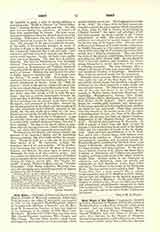

Grey Nuns. —The Order of Sisters of Charity of the Hopital General of Montreal, commonly called Grey Nuns because of the color of their attire, was founded in 1738 by the Venerable Marie-Marguerite Dufrost de Lajemmerais (Madame d’Youville) and the Rev. Louis M. Normand du Faradon, at that time superior of the Seminary of St. Sulpice of Ville Marie (now Montreal). Madame d’Youville’s first associates were Mlle. Louise-Thaumur Lassource, Mlle. Demers, and Mlle. Cusson. The four ladies rented a small house, and began by receiving four or five poor people, which number shortly rose to ten. This beginning was made October 30, 1738. On June 3, 1753, the little association of ladies received the royal sanction which transferred to them, under the title of “Soeurs de la Charity de l’Hopital General”, the rights and privileges which had been granted by letters patent to the “Freres Hospitaliers” in 1694. The peculiar dress of the sisterhood was adopted by mutual consent and worn for the first time on August 25, 1755. The rule which had been given Madame d ‘Youville and her companions by Father Normant in 1745 received episcopal sanction in 1754, when Msgr. de Pontbriant formed the little society into a religious community. This rule forms the basis of the present constitutions, which were approved by Leo XIII, July 30, 1880. Besides the three vows of poverty, chastity, and obedience, the Sisters pledge themselves to devote their lives to the service of suffering humanity. The Grey Nunnery offers a. refuge to old people of both sexes, incurables, orphans, and abandoned children or foundlings. Hundreds of these waifs are received yearly into the institution.
Montreal alone possesses fifteen charitable institutions under the care of the Grey Nuns, viz., orphan-ages, infant schools, homes for the infirm and aged, an academy for the blind; hospitals, a night refuge and two servants’ homes. Ten others are in parishes outside of the city and eleven in the United States, namely, in Boston, Salem, Lawrence, Worcester, and Cambridge (Massachusetts), Nashua (New Hampshire), Toledo (Ohio), Morristown (New Jersey), and Fort Totten (North Dakota). These cities possess homes for working girls, hospitals, and orphanages. In the latter upwards of twelve hundred poor children are cared for and instructed. Three large convents were also erected by the mother house with the rights of founding others in turn, viz., those of St. Hyacinth, Quebec, and Ottawa, but they are distinct branches, independent of the “Hopital General” (or Grey Nunnery). Nicolet has branched from St. Hyacinth. In 1844 a colony of Grey Nuns left their convent in Canada to devote their lives to the relief of the Indian tribes and the education of youth in the far Northwest. Their principal establishment is at St. Boniface, and is now a vicarial house, with thirteen other missions in the archdiocese. These include hospitals, and parochial, boarding, and industrial schools. St. Boniface Hospital, conducted by the Grey Nuns, is the largest in Manitoba, affording ample accommodation for three hundred and forty patients. In the province of Alberta, Diocese of St. Albert, the Sisters have hospitals at Edmonton and Calgary, and parochial, boarding, and industrial schools at St. Albert, Dunbow Saddle Lake. Further north, in the Vicariates of Athabasca and Mackenzie, there are schools and orphanages at Fort Resolution (Great Slave Lake) and also at Providence on the banks of the Mackenzie River. This last mission was founded in 1866. These houses have each a local superior who is subject to the superiors vicar of St. Boniface or of St. Albert, who in turn owe allegiance to the superior general of the Grey Nunnery, Montreal. In the year 1906 the number of professed Grey Nuns was 1893; charitable and educational establishments committed to their care numbered 135. In the former 6960 poor inmates are provided for, and in the latter 25,964 children are instructed.
SISTER M. E. WARD

